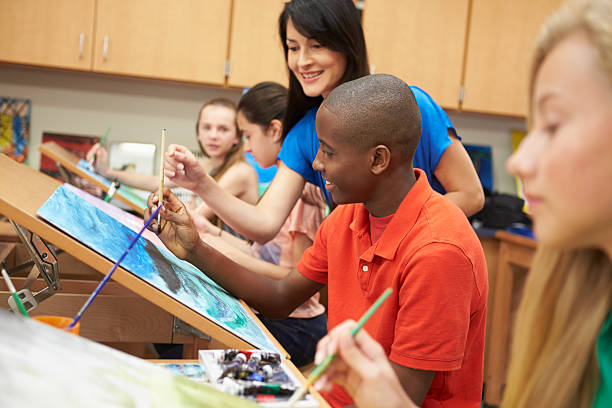In today’s fast-paced, information-heavy world, critical thinking has become an essential skill. It allows individuals to analyze, evaluate, and create solutions to complex problems. One of the most effective yet often underappreciated avenues for fostering critical thinking is through visual arts education. The arts offer unique opportunities for students to engage in creative problem-solving, self-expression, and critical analysis. This article explores how visual arts education enhances critical thinking skills by delving into several aspects of the learning process, its benefits, and real-world applications.
The Importance of Critical Thinking in Education
Critical thinking is the ability to analyze information, reflect on different perspectives, and apply logical reasoning to come up with reasoned conclusions. It’s a skill highly valued across various fields, from science to business, because it equips individuals to navigate complexities in both professional and personal settings.
The development of critical thinking in education is vital because:
- It encourages independent learning and self-reflection.
- It fosters better problem-solving and decision-making skills.
- It helps students challenge assumptions and see issues from multiple perspectives.
Many educational programs focus on fostering critical thinking through subjects like math and science. However, visual arts education has a unique capacity to nurture these skills in more creative, open-ended ways.
What Is Visual Arts Education?
Visual arts education encompasses a broad range of disciplines, including painting, drawing, sculpture, digital media, photography, and design. It involves both the study of art history and the hands-on creation of art. The goals of visual arts education extend beyond teaching technical skills; it encourages students to think creatively, engage in the interpretation of visual data, and explore abstract concepts through tangible means.
The process of creating and analyzing art allows students to:
- Explore personal ideas and emotions.
- Experiment with different materials and techniques.
- Critically assess the work of others as well as their own creations.
These activities are intrinsically linked to the development of critical thinking skills.
Fostering Creativity and Innovation
Visual arts education provides students with the freedom to explore diverse ideas and express them in creative formats. When students are encouraged to think outside the box and experiment with their work, they are also developing innovative thinking skills. This is crucial for critical thinking, which often requires looking at problems from different angles.
By allowing students to experiment and take risks in their work, visual arts education helps them develop:
- The ability to generate new ideas.
- Flexibility in thinking and adapting to new approaches.
- Confidence in exploring uncharted territory.
Through this creative freedom, students learn to question conventional solutions and explore new possibilities, all while sharpening their ability to assess and refine their ideas.
Engaging in Problem-Solving
Problem-solving is at the heart of critical thinking, and visual arts education offers countless opportunities for students to engage in this process. Whether it’s deciding how to represent an idea in a drawing or finding a solution to a design challenge, students are constantly required to think critically about their work.
Some ways that visual arts education nurtures problem-solving include:
- Encouraging students to explore multiple solutions to visual challenges.
- Pushing students to refine their techniques or strategies when their first attempt doesn’t work.
- Enabling them to make decisions about which materials and methods will best convey their ideas.
For example, when a student works on a sculpture, they must plan, adapt, and troubleshoot throughout the process. This iterative process of trial and error enhances their ability to critically assess situations and create viable solutions.
Enhancing Observation and Analytical Skills
A key aspect of critical thinking is the ability to observe details, analyze information, and draw conclusions. In visual arts education, students are often asked to carefully observe their subjects, whether it’s studying the anatomy for a life drawing or analyzing the composition of a famous painting. These exercises strengthen their observation skills, which is the foundation for analytical thinking.
When students are asked to critique artworks, they must:
- Identify and interpret visual elements such as color, form, texture, and composition.
- Evaluate the effectiveness of the artwork in communicating a message or emotion.
- Consider historical, cultural, or social contexts and how they influence the interpretation of the piece.
This type of analysis requires careful thought, attention to detail, and a deep understanding of context, all of which are essential components of critical thinking.
Encouraging Reflection and Self-Evaluation
An essential part of visual arts education is the practice of self-evaluation and reflection. Students are often encouraged to review their own work, considering what works and what could be improved. This reflective process helps them develop the ability to critique their own ideas and think about their work in a broader context.
The process of self-reflection fosters critical thinking by:
- Encouraging students to assess their creative decisions and the effectiveness of their outcomes.
- Helping them identify strengths and weaknesses in their approach.
- Inspiring continuous improvement and growth.
By regularly engaging in self-reflection, students develop a habit of critical self-assessment, which is essential not only in art but also in any academic or professional field.
Cultivating Open-Mindedness and Perspective-Taking
Critical thinking involves the ability to see things from multiple perspectives and challenge one’s preconceived notions. Visual arts education plays a significant role in developing this skill by exposing students to a variety of cultures, styles, and artistic traditions. When students are introduced to diverse artistic expressions, they are encouraged to consider different viewpoints and cultural contexts, fostering a more open-minded approach to problem-solving.
For instance:
- Learning about art from various cultures teaches students to appreciate different ways of seeing the world.
- Engaging with abstract or conceptual art challenges students to think beyond literal interpretations and explore deeper meanings.
- Participating in group critiques helps students understand how others may interpret the same artwork differently.
By encouraging students to embrace diverse viewpoints, visual arts education enhances their ability to approach problems with flexibility and an open mind.
Building Resilience and Perseverance
The creative process in visual arts education is not always straightforward. Students often encounter challenges, setbacks, and even failures while creating their work. Learning how to handle these difficulties is a crucial aspect of developing resilience, a key component of critical thinking.
Resilience in visual arts education teaches students to:
- Embrace failure as part of the learning process.
- Persevere in the face of challenges and find solutions through continued effort.
- Develop a mindset that views obstacles as opportunities for growth.
This ability to push through creative blocks and continue working towards a solution fosters a resilient attitude that translates into critical thinking in other areas of life.
Real-World Applications of Critical Thinking Through Art
The skills developed through visual arts education are not confined to the art studio; they have valuable real-world applications. Employers across various industries, from technology to healthcare, are increasingly looking for individuals who can think critically and creatively. The ability to approach problems from different angles, generate innovative solutions, and critically evaluate outcomes are all highly sought-after skills in today’s job market.
In addition, visual arts education enhances communication skills. Being able to convey complex ideas visually is a powerful tool in fields such as marketing, design, and even data analysis. By learning to express ideas through art, students develop the ability to communicate more effectively and persuasively.
Conclusion
Visual arts education offers a powerful platform for enhancing critical thinking skills. Through creativity, problem-solving, observation, self-reflection, and open-mindedness, students are equipped with the tools necessary to think critically in a variety of contexts. As schools and educational systems continue to emphasize the importance of critical thinking, integrating visual arts education into the curriculum can provide students with unique opportunities to develop this essential skill. The arts encourage flexibility, resilience, and a willingness to explore new ideas—all key components of a strong critical thinker.




